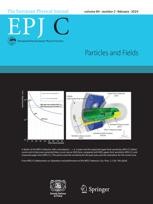Factoring in gravitomagnetism could do away with dark matter
Models of galactic rotation curves built of a general relativistic framework could use gravitomagnetism to explain the effects of dark matter.
New York | Heidelberg, 4 March 2021
 Observations of galactic rotation curves give one of the strongest lines of evidence pointing towards the existence of dark matter, a non-baryonic form of matter that makes up an estimated 85% of the matter in the observable Universe. Current assessments of galactic rotation curves are based upon a framework of Newtonian accounts of gravity, a new paper published in EPJ C, by Gerson Otto Ludwig, National Institute for Space Research, Brazil, suggests that if this is substituted with a general relativity-based model, the need to recourse to dark matter is relieved, replaced by the effects of gravitomagnetism.
Observations of galactic rotation curves give one of the strongest lines of evidence pointing towards the existence of dark matter, a non-baryonic form of matter that makes up an estimated 85% of the matter in the observable Universe. Current assessments of galactic rotation curves are based upon a framework of Newtonian accounts of gravity, a new paper published in EPJ C, by Gerson Otto Ludwig, National Institute for Space Research, Brazil, suggests that if this is substituted with a general relativity-based model, the need to recourse to dark matter is relieved, replaced by the effects of gravitomagnetism.
The main role of dark matter, Ludwig points out in the paper, has historically been to resolve the disparity between astrophysical observations and current theories of gravity. Put simply, if baryonic matter — the form of matter we see around us every day which is made up of protons, neutrons and electrons — is the only form of matter, then there shouldn’t be enough gravitational force to prevent galaxies from flying apart.
By disregarding general relativistic corrections to Newtonian gravity arising from mass currents, and by neglecting these mass currents, Ludwig asserts these models also miss significant modifications to rotational curves — the orbital speeds of visible stars and gas plotted against their radial distance from their galaxy’s centre. This is because of an effect in general relativity not present in Newton’s theory of gravity — frame-dragging or the Lense Thirring effect. This effect arises when a massive rotating object like a star or black hole ‘drags’ the very fabric of spacetime along with it, in turn giving rise to a gravitomagnetic field.
In this paper, Ludwig presents a new model for the rotational curves of galaxies which is in agreement with previous efforts involving general relativity. The researcher demonstrates that even though the effects of gravitomagnetic fields are weak, factoring them into models alleviates the difference between theories of gravity and observed rotational curves — eliminating the need for dark matter. The theory still needs some development before it is widely accepted, with the author particularly pointing out that the time evolution of galaxies modelled with this framework is a complex problem that will require much deeper analysis.
Ludwig concludes by suggesting that all calculations performed with thin galactic disk models performed up until this point may have to be recalculated, and the very concept of dark matter itself, questioned.
References: G. O. Ludwig (2021), Galactic Rotation Curve and Dark Matter According to Gravitomagnetism, European Physical Journal C 81:186, DOI 10.1140/epjc/s10052-021-08967-3
Further Information
For more information visit: www.epj.org
Services for Journalists
The full-text article is available open access here.
Contact
Sabine Lehr | Springer | Physics Editorial Department
tel +49-6221-487-8336 | sabine.lehr@springer.com
